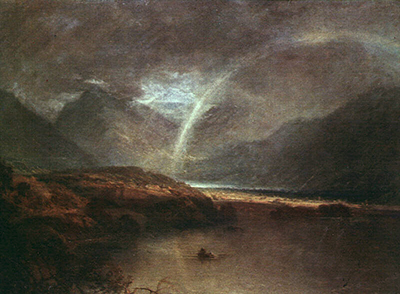Buttermere is a lake in the North of England of around 2km in length. It remains one of the biggest draws of the Lake District, a region famed for its picturesque beauty.
Turner clearly became aware of this himself and would journey to this area several times. It could fulfil his passion for hills and mountains, whilst also combining large lakes such as this. The area was therefore ideal for his painting style, which included both. It was in 1798 that this particular painting was exhibited, making it likely that he painted it in that year as well - the artist typically exhibited his work at the Royal Academy just as soon as it was ready. We believe that in the previous year he had visited this spot for the very first time, no doubt producing large numbers of drawings and watercolours in order to best remember that visit.
It is likely that a watercolour with dramatic weather was the inspiration for this piece, and he may have literally sat with it next to him whilst completing this piece. We find a dramatic use of light here, with a veil of darkness covering most of the scene. A small boat creeps forward tentatively in order to provide us with a sense of scale, something Turner did in many of his sprawling landscape scenes. The light that he does allow in comes from an arcing rainbow which crashes into the painting from the right hand side, helping to reveal detail on the central part of the piece. It continues to arch further via the reflection which sits on the sea below. At the far back we find menacing clouds which lurk above a brighter section of sky.
In all, this is another representation from the artist of the vulnerability of man in the face of nature, though without quite the drama as found in some of his ship wreck scenes. This is a more romantic look, where a calm can be appreciated in parts of the canvas. This style may remind some of the later work of the Hudson River School, whose exponents included Thomas Cole and Albert Bierstadt. You will see clear influence from both Turner and also the earlier Claude in their own work, though the content switches to the dramatic landscapes of North America.




